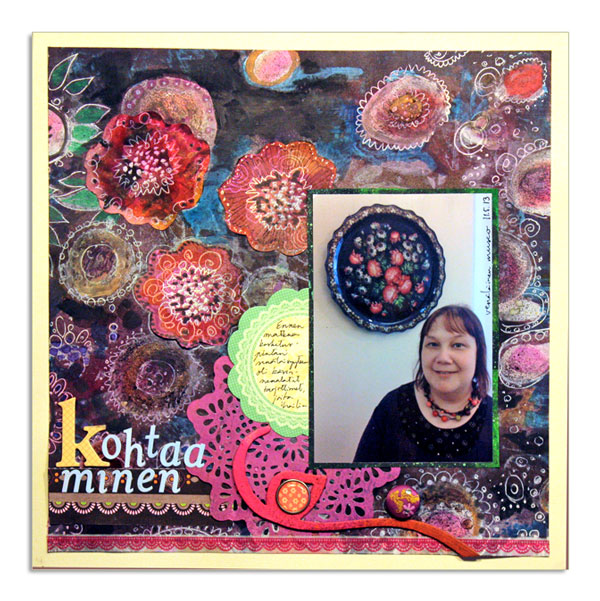Watercolor Wisdom – 6 Techniques that You Need to Try Before Giving Up!

This week I am writing to you who have always liked the idea of using more watercolors but whose experiments don’t often last long. Try these techniques to keep going and not giving up!
1) Doodle with a Brush
Dip a thin brush into the paint and start doodling! Add more paint to some areas so that the thickness of the line varies and evokes new shapes.
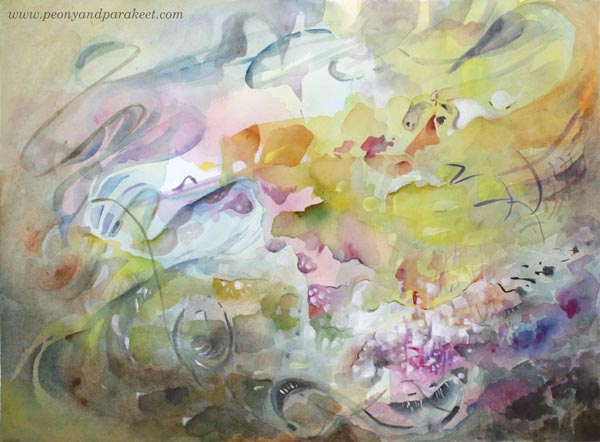
I have also used acrylic paints for finishing this piece called “Netfishing.”
2) Doodle with Masking Fluid
I don’t often recommend purchasing more art supplies to boost the motivation, but with watercolors, I highly recommend buying masking fluid. For example, Daniel Smith has a masking fluid that comes with handy applicators. You can just pick the bottle and start doodling. And while you are doing that why not fill the whole paper with them! Then add several layers of paint and remove the fluid gradually.
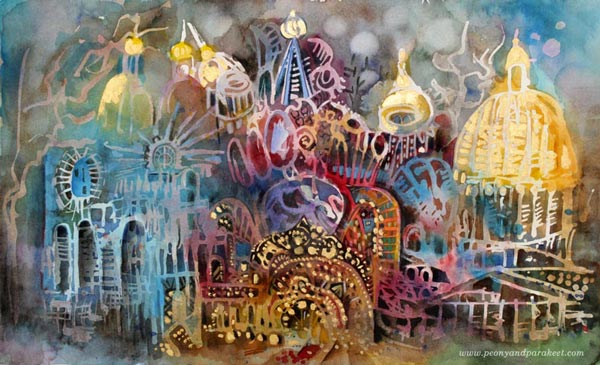
I have also used golden acrylic paint and colored pencils in this piece, called “Three Churches of St. Petersburg”.
3) Add Geometric Shapes to a Scenery
If all the elements are realistic, defined and “make sense,” you are underestimating the potential of watercolors. An easy way to push beyond the conventional is to add geometric shapes to a realistic theme, for example, to a scenery.
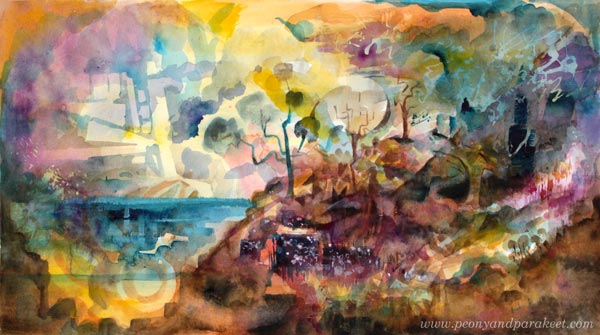
You can also paint vice versa: start with the geometry and then make it look like scenery.
4) Leave Blank Spots to Express the Light
Think about your painting as a collection of layers. Paint 6-10 layers so that every layer is a bit smaller than the previous one. Leave blank spots when painting the first layer. Focus on tiny details in the last layers. Let every layer dry before adding a new one.
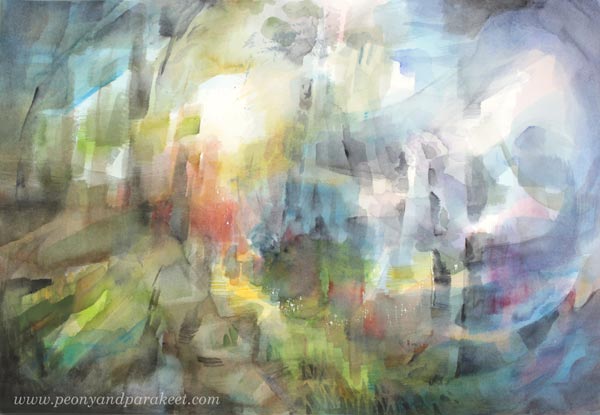
5) Add Muddy Colors to Make the Brights Shine
Don’t be afraid of dark areas. If your work looks unfinished or the colors don’t shine no matter how much you add them, the solution is to add more really dark areas.

There are a lot of browns, greys, and blacks in these two small sceneries which make the color glow!

6) Pick One Dominating Color, but Use Many Tones of It
When applying paint on paper, add small drops of other colors too. Use the transparency of watercolors to get new tones: add watery paint, let dry, repeat!
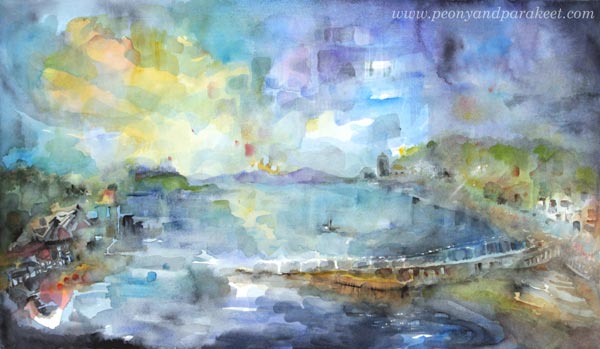
“Oban,” a small town in Scotland that left an impact on me. I could have painted the sky solid blue, as well as the water, but adding more variation of the color makes this painting.
Watercolor Journey – More Watercolor Wisdom for Self-Study!
The pictures and tips of this blog post are picked from my class Watercolor Journey. In this class, you will learn how to use the techniques and the imagination to express energizing sceneries. The fun thing is that these sceneries can be either realistic, or imaginative, or anything between. Sometimes the scenery is born with the technique. Other times painting is more about reconnecting with a happy memory. I have tried to make the videos as inspiring as possible so that you and your watercolors become a better match after each one.
>> Buy Watercolor Journey!
Paint Your Mental Images!
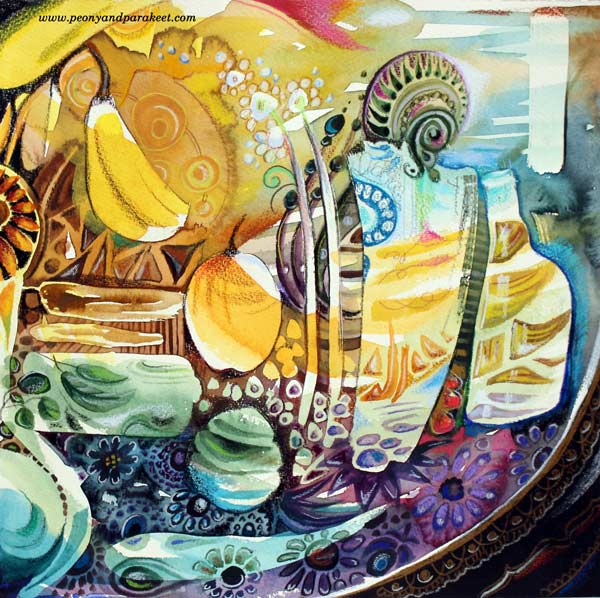
This artwork is inspired by the subject that keeps on fascinating me: beautiful objects like Russian handpainted plates! My admiration for them began many years ago, and only got stronger when I saw them in 2013 at St. Petersburg, Russia.
Here’s a scrapbook page which I made back then. My husband took the snapshot in The Russian Museum. Even if I look a bit worn out from the amount of walking we did during our travel, I love how my clothing and the plate match up!
We also bought one plate as a souvenir. I placed it on the table near me while finishing the painting. Just to keep me inspired to fine-tune all the details. But let’s not go that far yet! Before that, a lot happened, in my mind at least!

From Photos to Mental Images
Before starting the painting, I spent quite a lot of time thinking what to paint and how. I feel that it is easiest to think while walking, so I took the dogs out to the snowy nature. Then I took some photos, which is also a great way to observe and examine things.
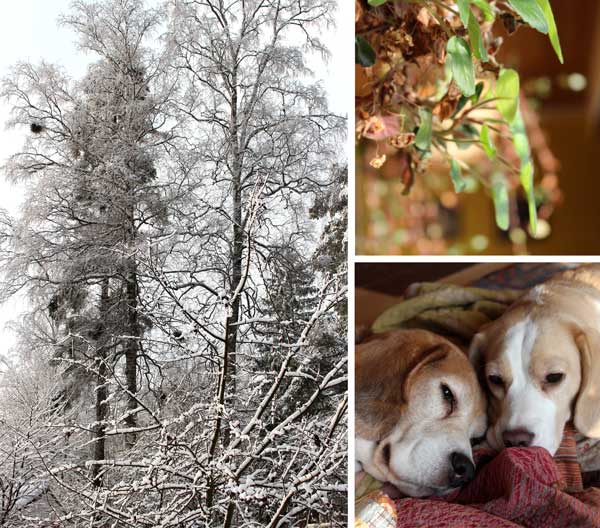
After my beagles had fallen asleep, I browsed the photos. “There’s a difference of how I those subjects in my mind,” I thought. If I think of a Russian plate, I might see one detail of it, then other images come to the mind, then the fraction of a Russian plate again. The thoughts move so quickly that the images seem to get mixed up and change.
I could not help looking up what psychology says about it. Yes, there’s a concept called mental image and several theories about how mental images are formed in the mind.
What I find fascinating is, that when creating art, we tend to pick one photographic image instead of a mental image. Then we get disappointed when the artwork does not represent the realistic, photographic image. Replicating the photographic image to the mental image is extremely hard. Let’s try! Look at any of the photos above, then close your eyes and imagine every little detail of the image – impossible! Similarly, if you read a story for the first time, then try to repeat it exactly from word to word, you will certainly fail! But could we paint what we remember and see in our minds, like Edward Munch said: “I painted only memories, adding nothing, no details that I did not see.”
Using Mental Images in Art
I thought it would be both philosophically and practically interesting to use the mental image as a starting point for a painting. So, I decided to paint the mental image of my souvenir, the decorated plate. I forcefully thought about the plate for few minutes. But at the same time (as focusing on one thought is so dull), I was also cleaning. When I grabbed the morning newspaper to put it away, I saw an article of Paul Gauguin‘s artwork being sold at a high price. Just when I had gathered my thoughts around the Russian plates, there it was, a picture of Gauguin’s art! Whoosh … my mental image changed to a mixture of a decorative plate and Gauguin’s art, not just that specific one but many others too that I have seen!
While walking towards the room where I create art, I saw a banana on the kitchen counter, then thought about the wine we are going to taste to celebrate my coming birthday. My mind wondered towards glass objects – how I love them and how I should really paint only them … Before I began painting, my mental image had grown into a huge collage!
The complex thing in mental images is, that if you think very visually, holding the static view is difficult. Instead of trying to focus on one thing only, let it go and replace it with a more general subject. I chose my love for decorative art, beautiful concrete things and how they are at their best when they represent the beautiful shapes and shades from nature.
Instead of trying to build one controlled mental image first, accept the short-term, fractional nature of them. My artwork could be a collection of mental images appearing while I work. To emphasize that, I decided to start the painting with masking fluid. That way I could not even start building one complete image.
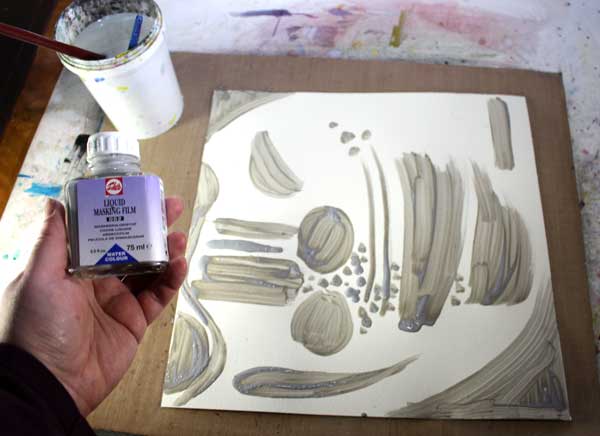
Masking Fluid
… or liquid masking film as my bottle says creates a rubber-like surface which you can remove afterward. You can add as many layers of paint as you like, then remove the masking fluid and you still have white areas to fill – or you can pick a colored area which you want to preserve and cover it with the fluid. It is a great way to obtain a layered look without too much thinking. Just remember to let the fluid dry properly before moving forward.
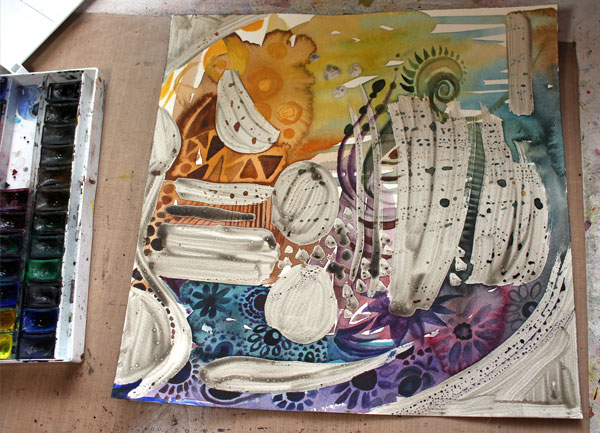
You can remove the dried fluid easily just by pulling it off with your fingers. With the help of the fluid, I was able to create very detailed areas before focusing on bigger objects so that they still look very sharp.
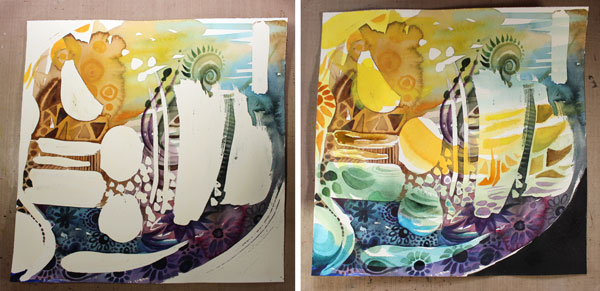
The painting was finished with colored pencils. The process was very similar to the one I teach in the video “Watercolor 101 for Intuitive Painting“, I just added the masking fluid before starting to paint with watercolors.
Here are some details of the finished piece:
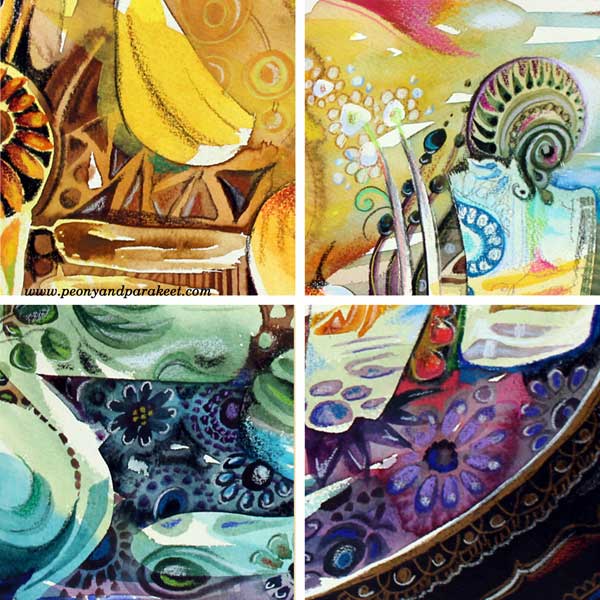
And here’s the painting again:
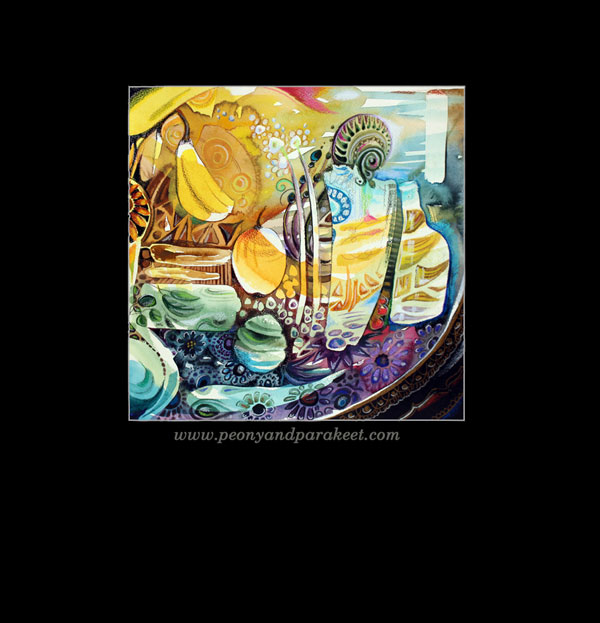
Before finishing, I realized that the banana from the kitchen counter had made it’s way to the painting. It seemed awkward at first but then, why not accept it to be the part of this surrealistic still life, surprisingly exact copy of the collection of my mental images!
What do you think? Could increasing intuition and including mental images improve your art?
Combine ideas with techniques – Buy Imagine Monthly Art Journaling Bundle!

